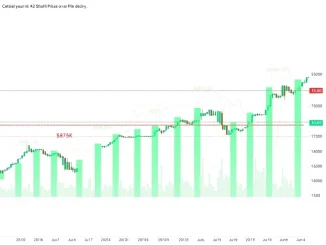
Hey crypto enthusiasts! Have you been following the latest news from the world of Bitcoin mining? There’s a significant development that’s catching everyone’s eye: miner profits have taken a sharp downturn, hitting levels not seen in months.
What’s Driving the Plunge in Bitcoin Miner Profits?
According to recent data shared by CryptoQuant on X, Bitcoin miners are experiencing their weakest earnings period in quite some time. Daily revenue across the network dropped significantly in June, reaching a low of around $34 million. This marks the lowest daily earning figure seen since April.
So, what’s causing this dip? It’s primarily a combination of two factors:
- Falling BTC price: When the price of Bitcoin decreases, the value of the rewards miners earn for validating blocks also decreases in dollar terms.
- Declining transaction fees: Transaction fees, which supplement the block reward, have been relatively low recently. This reduces the overall revenue stream for miners.
These two forces are putting pressure on miner profits and making the operation less lucrative than it was earlier in the year.
How Do Low Transaction Fees Impact Bitcoin Mining?
For a long time, the primary revenue source for Bitcoin mining was the block reward – the new BTC minted with each block found. However, transaction fees paid by users have historically provided a variable but sometimes significant boost to earnings, especially during periods of high network congestion. When transaction activity slows down or users opt for cheaper transaction methods, these fees dwindle. For miners operating on thin margins, the reduction in transaction fees directly cuts into their bottom line, making profitability harder to achieve, especially when combined with a lower BTC price.
What Does This Mean for the Crypto Market?
The profitability of Bitcoin mining is a key indicator for the overall health and sentiment within the crypto market, particularly concerning Bitcoin. When miner profits fall sharply, it can lead to several outcomes:
- Miner Stress: Less efficient miners with high operating costs (electricity, hardware, overhead) may struggle to remain profitable and could be forced to shut down.
- Increased Selling Pressure: Some miners might need to sell more of the BTC they mine (or even their existing holdings) to cover operational expenses, potentially adding selling pressure to the crypto market.
- Difficulty Adjustments: If enough miners go offline, Bitcoin’s mining difficulty will adjust downwards, making it easier for the remaining miners to find blocks and potentially increasing their share of rewards, helping to stabilize the situation over time.
- Industry Consolidation: The downturn can accelerate consolidation, with larger, more efficient mining operations acquiring smaller, struggling ones.
Monitoring miner profits provides valuable insight into the supply side of Bitcoin and the operational health of a core industry component within the crypto market.
Navigating Challenges in Bitcoin Mining
The current environment presents clear challenges for those involved in Bitcoin mining. High energy costs in many regions, increasing competition requiring constant hardware upgrades, and the inherent volatility of the BTC price are constant hurdles. The recent drop in transaction fees only adds to this pressure. Miners must constantly seek efficiency improvements, from sourcing cheaper renewable energy to deploying the latest, most power-efficient Application-Specific Integrated Circuit (ASIC) miners.
What’s Next for Bitcoin Mining Operations?
Despite the current dip in miner profits, the Bitcoin mining industry is resilient and constantly adapting. Operators are exploring various strategies to navigate these challenging periods:
- Efficiency Upgrades: Investing in newer, more efficient mining hardware to reduce electricity consumption per terahash.
- Energy Strategy: Securing favorable, long-term power purchase agreements, often leveraging renewable energy sources.
- Financial Hedging: Utilizing financial instruments to hedge against BTC price volatility.
- Diversification: Some larger operations explore mining other cryptocurrencies or offering related services.
While the recent data highlights a tough patch, it also underscores the dynamic nature of the industry. The ability to adapt to changing conditions, including fluctuations in the BTC price and transaction fees, will determine which operations thrive.
Summary: A Temporary Setback or a Trend?
The recent report from CryptoQuant showing Bitcoin miner profits falling to $34 million daily, the lowest since April, is a clear signal of the pressures currently facing the sector. Driven by a softer BTC price and lower transaction fees, this downturn impacts Bitcoin mining operations globally and is a key data point for anyone observing the crypto market. While challenging, the industry has a history of overcoming such hurdles through innovation and adaptation. How miners respond to this profitability squeeze will be crucial to watch in the coming months.



